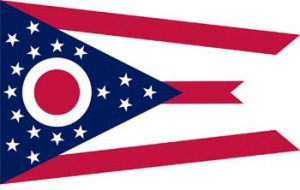Ohio Emergency Vehicle Light State Statutes
 According to the statutes set in law on a state by state basis, each state has their own set of rules on what is used and allowed on emergency and public safety vehicles. This is a look at the state of Ohio's specific statutes on what constitutes the correct lighting on emergency vehicles. Ohio's state statutes have little information about the specific lights used on different emergency and public safety vehicles, but what is written about the topic can be gleaned from one statute in particular that will be explored in the following sections.
According to the statutes set in law on a state by state basis, each state has their own set of rules on what is used and allowed on emergency and public safety vehicles. This is a look at the state of Ohio's specific statutes on what constitutes the correct lighting on emergency vehicles. Ohio's state statutes have little information about the specific lights used on different emergency and public safety vehicles, but what is written about the topic can be gleaned from one statute in particular that will be explored in the following sections.
Law Enforcement Vehicles
For police vehicles, Ohio statute 4513.17 (clause d) states that a law enforcement vehicle is equipped with red and white flashing or rotating lights. Along these same lines, only law enforcement vehicles and other vehicles involved with enforcing criminal and/or traffic law may be allowed to use blue, or blue and white police lights on their vehicles. Those lights can also flash, rotate, or oscillate.
Fire Trucks
Within the same statute of 4513.17 (clause d), it is stated that fire trucks use either just red, or red and white flashing or rotating lights. These fire truck lights may be used in the process of an emergency, along with a siren to indicate awareness and caution to other motorists on the roads.
Volunteer Fire Fighter Vehicles
Because of statute 4511.01 (clause e), volunteer fire fighter vehicles are considered public safety vehicles when responding to an emergency and may use the same lighting as other emergency response vehicles; red, or red and white flashing or rotating lights. However, if used outside of an emergency and on a roadway, these volunteer vehicles are subject to a misdemeanor.
Ambulances
Like fire trucks, the 4513.17 (clause d) statute states that ambulances may use the same red, or red and white lights while sometimes accompanied by sirens. Statute 4511.01 indicates that these ambulances include private ambulance companies as long as they're under contract to the county or are registered to be emergency service vehicles, or public safety vehicles.
Tow Trucks
According to clause c of the Ohio 4513.17 statute, tow trucks and other such maintenance vehicles- while on the road- may use an amber light that flashes, rotates, or oscillates (has a pendulum-like, swaying pattern).
Construction Vehicles
Again, like tow trucks, statute 4513.17 (clause c), indicates that any type of road service and/or maintenance vehicle be equipped with an amber light that flashes, rotates, or oscillates.
Utility Vehicles
 Statute 4513.17 (clause c) also includes any type of working vehicle as needing an amber light. However, it is stated that alongside an amber, or an amber and white light, that utility vehicles may only display these lights while in the process of completing a work task. Otherwise, those lights are required to be off.
Statute 4513.17 (clause c) also includes any type of working vehicle as needing an amber light. However, it is stated that alongside an amber, or an amber and white light, that utility vehicles may only display these lights while in the process of completing a work task. Otherwise, those lights are required to be off.
Pilot Vehicles
Pilot vehicles (escort vehicles whose duty is to direct trucks with oversized loads or convoys of vehicles for specific purposes) in Ohio are required to have a rotating or strobing (intermittent flashing) light affixed horizontally to them. This light must be able to be seen at a five hundred foot distance and from every direction. There is no statute that specifically states this but the Ohio State Highway Patrol recognizes it as a known regulation for such vehicles.
Security Vehicles
Using information found in statutes 4511.01 and 4513.17, one can assume that, because there are no specific laws pertaining to security vehicles used on private business property, such security vehicles may use amber and/or white lights when on the privately owned property. It is stated within these statutes that a vehicle may use such lights that either flash, oscillate, or rotate for private use, outside of the commercial roadways. Using such lights to increase visibility and caution in a private parking lot would be a viable explanation of this law.
Additional Information
One of the few instances that these vehicle light statutes isn't required is when a police officer must temporarily use a regular motor vehicle in an emergency. At that time, the vehicle is still considered an emergency vehicle because of the police officer's response to an emergency (Statute 4511.01). In order to be considered an emergency service vehicle, private medical service organizations must register those vehicles and pay certain taxes and fees. In return, they get emergency service status and are equipped with the necessary tags and license plates to proclaim themselves as such (Statute 4503.49). Because of this particular process, even vehicles with the duty of organ transplant transportation may be registered as emergency service vehicles, and is stated as such also in statute 4511.01.
For more information about what strobe lights may be available to you, or the use of a cop siren, we suggest calling your State Highway Patrol office at: 614-466-2660
*Please note that these numbers are what we are currently able to find and the numbers may have changed since this listing.
Disclaimer: The emergency vehicle light state statute guide was created by Extreme Tactical Dynamics as a guide and reference. We make no claim to the accuracy or validity of this guide. This guide was written to the best of our knowledge and has been provided to our customers as a courtesy ONLY! The information in this guide is our interpretation of the law as we have read it. We cannot be held responsible for any errors as this is only our interpretation of the law and the laws are constantly changing. We cannot be held liable or responsible for any errors and recommend that our customers refer to their local authorities to confirm the particular statue that governs their use of emergency vehicle lights.
 Facebook
Twitter
Google+
Instagram
YouTube
Facebook
Twitter
Google+
Instagram
YouTube


